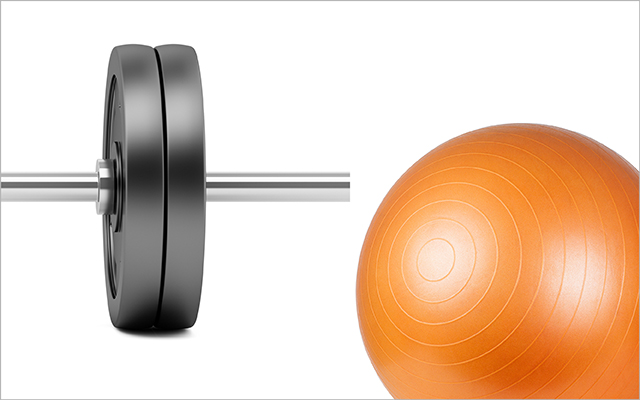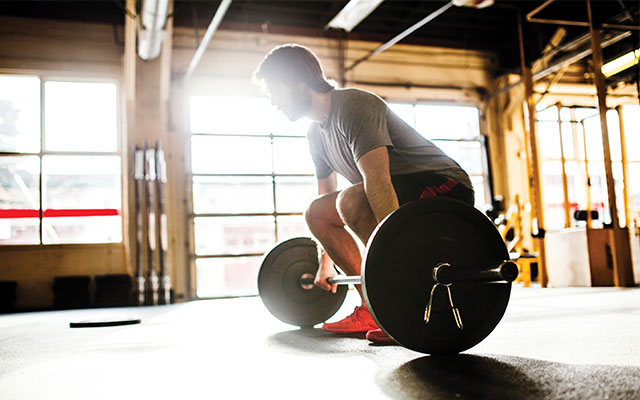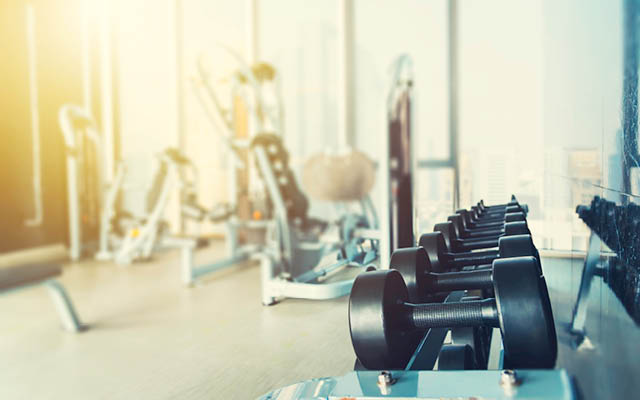New gym myths seem to pop up overnight. Some die off quickly: Do all your exercises standing on one foot! Others hang around because they’re appealing: Eat all the carbs you want before a 5K! Or because they just sound true: Strength training makes you bulky! Or because they excuse us from doing something difficult: Deadlifts will hurt your back!
It’s hard to fault people for buying in to these maxims. “Everyone is looking for the secret to what works. So they’re ready to jump on the next bandwagon because maybe it’s the answer,” explains Rachel Cosgrove, CSCS, an award-winning personal trainer and author of The Female Body Breakthrough and Drop Two Sizes.
We’re here to help you sort the wisdom from the bunk. Below are 11 of the most pervasive gym legends out there. Some are true, some are false, and some fall somewhere in between.
We’ve asked top experts in nutrition, exercise, weight loss, and athletic performance to weigh in, and then we ranked each adage on a scale of 1 (rubbish) to 10 (ironclad), setting the record straight based on the latest science and years of experience. So the next time someone tells you that running will wreck your knees, that gain requires pain, or that you can’t be healthy if you’re a size 16, you’ll not only know if what they’re saying is true — you’ll also know why.
1. TRUE or FALSE? Machines are safer than free weights.
TRUE. But free weights are still the better option.
Resistance-training machines like the leg press, leg extension, and lat pull-down might look like medieval torture devices to first-time gym-goers. In truth, though, it’s the benign-looking barbells and dumbbells that cause most weight-training injuries. More than 90 percent of strength-training-related accidents in the United States involve free weights, according to a 2010 study.
This doesn’t mean you should banish them from your workouts. The key to reaping the benefits of barbells and other free weights without sacrificing safety is learning proper form. Consult with a trainer or certified coach, start light, and be patient with yourself as you try new moves with new tools. “There’s no substitute for learning correct form and making sure not to force moves when you’re too tired to execute them properly,” advises Alex Hutchinson, PhD, author of Which Comes First, Cardio or Weights?
While machines provide a measure of safety, free weights offer their own benefits. A 2014 study found that six sets of barbell squats stimulated significantly more beneficial hormones than the same number of machine leg presses. Another study found that barbell bench presses activated more muscle tissue than a machine-based equivalent.
Since free weights force you to control a weight in all directions, they also teach better movement mechanics and body awareness, says Hutchinson. These skills translate readily into the functional movements of everyday life.
So, while machines have the edge in safety, free weights are the winner for improving overall athleticism and strength. As long as you’re mobile enough to perform free-weight moves with good form, most coaches and trainers consider them the way to go.
(Explore this guide to help you move from resistance machines to free weights.)
2. TRUE or FALSE? You don’t have to be “thin” to be healthy.
TRUE. Body fat is just one measure of health — and not a very accurate one.
It’s a misconception that thinness equates to glowing health. In truth, it’s quite possible to carry some extra weight and still be healthy.
A 2012 study from the Medical University of South Carolina identified lifestyle as one of the best predictors of long-term health. The study authors named four basic healthy habits that, if practiced regularly, minimize the impact of BMI (body-mass index, the ratio of your height and weight) on longevity:
- Exercise regularly.
- Eat five servings of vegetables and fruits daily.
- Refrain from smoking.
- Drink alcohol in moderation.
“A person who has more body fat but less stress and who sleeps well, lifts weights a couple days a week, and eats vegetables and fruits is often healthier than someone with low body fat who doesn’t have the same healthy habits,” explains Cosgrove.
“Body fat is only one measure of health. It’s also important to have strength, flexibility, cardiovascular health, and healthy hormonal levels,” she continues. And those factors are influenced as much or more by what you do than what you weigh.
3. TRUE or FALSE? Running is bad for your knees.
FALSE. However, bad running form is bad for your knees.
“This is false,” says Andy Galpin, PhD, CSCS*D, an exercise physiologist at California State University, Fullerton. “But it can be true.”
Perfect running form should be painless, he explains. “The human body developed to move far more than we do now. Historically, if a person couldn’t handle 20, 30, or 40 miles of running per week, he’d starve.”
These days, people run for different reasons, and they often jump into the sport too quickly and too intensely after years of sedentary living. “Jamming a new stimulus on the body like that is asking for trouble,” he says. “It’s too rapid a progression.” Pain in the feet, back, hips, and especially knees is the all-too-common outcome. According to a 2011 poll, 13 percent of runners suffer from knee pain.
The solution? Take it slow and focus on form, says Galpin: “Your knee should track over your foot, not inside or outside of it. Your toes should track forward, not in or out. And you should feel equal pressure on the inside and outside edges of your foot each time you stride.”
And strive for quality over quantity: Fewer miles of pain-free running with spot-on form is much better than more miles of painful running with sloppy form.
To progress, says Galpin, “don’t increase your mileage by more than 10 percent per week.”
If pain persists, see a doctor — and maybe a running coach as well.
4. TRUE or FALSE? You need to load up on carbs before a race.
FALSE. Eat a balanced meal before a race.
To budding endurance athletes, carb loading may sound like a dream come true: Sign up for a 5K and you have carte blanche to scarf pasta, doughnuts, and candy for 24 hours prior to the event, since all those carbs will power you through the race.
It’s true that aerobic activities like distance running, cycling, and swimming are fueled by a combination of carbohydrates (in the form of a readily usable energy source called glycogen) and fat. There’s a limit to how much glycogen we can store, though — hence the practice of loading up on carbs prior to race time.
“Eating carbs before an endurance activity tops off the glycogen stores, allowing you to carry hours of accessible energy to get through most events,” says Adam Chase, coauthor of The Ultimate Guide to Trail Running and a veteran of more than 100 marathons and ultramarathons.
In practice, though, even a long race doesn’t burn nearly as many carbs as you might think. Unless you’re going to be racing for more than four hours, says Chase, a normal-size meal, balanced in protein and fats, and high in easily digested carbs (he recommends dark grains like quinoa and brown rice rather than white flour), is sufficient.
Take in much more than that and the extra energy will wind up right where extra calories go any other day of the week — around your middle.
5. TRUE or FALSE? Exercise makes you smarter.
TRUE. Working out has many positive effects on the brain.
Science has proven it: What’s good for the body is also good for the brain.
“Exercise helps memory and thinking through both direct and indirect means,” says Jeff Rosga, NASM-CPT, NASM-PES, senior director of Life Time Academy in Chanhassen, Minn. He notes that regular aerobic exercise boosts the size of the hippocampus, the part of the brain responsible for memory and learning. In older people, lifting weights and brisk walking improve spatial memory.
Exercise also stimulates the release of growth factors — substances that enhance neuroplasticity (the brain’s capacity to learn and adapt) by promoting the formation of new neural pathways, brain cells, and blood vessels.
Indirectly, exercise also initiates head-to-toe changes in body chemistry and physiological function, explains Rosga, all of which support brain health. Inflammation, stress, and anxiety decrease with regular movement, while mood, sleep, circulation, and digestion improve. All of these adaptations support a healthy, thriving brain.
6. TRUE or FALSE? Fasting before exercise burns more fat.
FALSE. Exercising after a small meal may burn more fat than a fasted workout.
It seems to make sense: Without food in your belly, your body draws energy from the fat on your belly — right?
In practice, though, it doesn’t work like that. (For more on this opice, see “Fasted Vs. Fed Training — Which Is Better?“)
A 2014 study found that women on a customized nutrition plan who performed aerobic exercise after an overnight fast lost no more fat than a second group who had a meal before their morning cardio sessions. Another study suggests that eating a small meal before a moderately intense exercise session may lead to greater excess postexercise oxygen consumption, or EPOC (the bump in your metabolic rate that happens in the hours following a workout) than eating nothing at all.
So if losing fat is your goal, research shows it’s worth having something in your stomach before your workout. Aim for a light meal that’s easy to digest and nutritious — a protein-packed smoothie or hard-boiled eggs are good options. (For more ideas, visit “Eating Before Early-Morning Workout” and “Be a Breakfast Believer”.)
That said, if you’re not hungry before working out, and your energy and performance don’t suffer, don’t force yourself to eat. Your body’s intuition may be more useful than studies or fads.
7. TRUE or FALSE? Squatting and deadlifting are bad for your back.
FALSE. Smart exercise techniques mitigate the risk of these strength-training essentials.
Barbell moves are gaining popularity among gym-goers, and you probably know someone who’s tweaked his or her back while squatting or deadlifting. (That someone may even be you.) Some gym-goers become so gun-shy of these key exercises that they swear off them altogether.
The problem isn’t with the exercises, though — it’s the way people perform them, says Mike Robertson, MS, CSCS, USAW, president of Robertson Training Systems in Indianapolis. “It’s not the lift that gets people injured, but poor form and technique.”
One key cause of bad form, he notes, is “ego lifting”: attempting to heft a heavy weight without working up to it gradually over time. It’s the equivalent of trying to pull off a triple-Lutz jump after your first ice-skating lesson.
To ensure that your form stays on point while you push your limits on the squat and deadlift, says Robertson, try this: Exhale fully, pulling your front ribs down. Simultaneously tilt the top of your pelvis back slightly, as if tucking an imaginary tail between your legs. “Now hold this posture and take a breath in. You should feel air go into the front, sides, and back of your core.” Hold that position throughout your set.
Can’t hold that position? Back off the weight, or try an easier version of the lift: Place the weight on a 4-inch platform when you deadlift, or perform a three-quarter or half-squat version instead.
8. TRUE or FALSE? Walking improves bone density.
TRUE. But you’ll build it faster if you hop, skip, and jump.
Like muscles, bones shrink without stimulation. Astronauts, for example, can lose 1 to 2 percent of their bone mass every month they spend in zero gravity. Sedentary elderly people lose about that much in a year.
Luckily, weight-bearing activity can help stave off bone loss, says Galpin. While walking is good, it isn’t your best or most time-efficient choice.
“In the elderly, the areas most vulnerable to osteoporosis — or bone loss — are the hips and pelvis,” he explains. To shore up those key areas, your most effective weapon is triple extension: explosive, simultaneous straightening of the ankles, knees, and hips. Think running, jumping, skipping, and hopping. If your bones are healthy, aim for about 40 jumps, skips, or hops per workout.
Not ready to bound around the block? No worries, says Galpin. “Any activity that puts pressure on your skeleton will help,” he says, noting that walking is an effective progression.
Strength training is also great for people who aren’t ready for the high impact of jumps. Try weight-bearing movements that involve standing and walking, such as farmers’ walks, squats, and deadlifts.
9. TRUE or FALSE? Lifting weights makes you bulky.
FALSE. Lifting weights makes you healthy and strong.
This is one of the more stubborn myths surrounding the practice of strength training — that anyone, male or female, who hefts a pair of dumbbells will transform into an Incredible Hulk.
That’s akin to believing that playing a few scales on a piano will turn you into Elton John. No one ever gained an appreciable amount of muscle mass without years of hard work in the gym and a devotion to a muscle-building diet. Most people’s muscles will get slightly larger on a strength-training program, but “bulk” is not something that happens by accident.
This is true of both sexes: “Women don’t gain muscle as easily as men because of their lower testosterone levels,” says Rosga. And men, who secrete about 10 times as much of the muscle-building hormone as women, hardly transform into muscle monsters overnight, even under optimal conditions. Most men on a focused muscle-gain program can expect to gain 4 to 7 pounds of lean body mass over 12 weeks. Gaining more muscle than that is the exception, not the norm. If you gain more, or start feeling “bulkier” than you prefer, it might be the result of fat gain or water retention; look at your nutrition and hydration for clues.
10. TRUE or FALSE? Pain is weakness leaving the body.
FALSE. Some soreness is normal when you exercise, but true pain is a warning sign that something is wrong.
A bout of hard exercise is not 100 percent comfortable. And a touch of DOMS — delayed-onset muscle soreness — a day or two after a gym session is normal, especially when you’re performing new tasks and exercises or after a particularly tough workout.
But stabbing pain in your back or joints? Pain that affects the way you walk, move, or play your sport? That’s another thing altogether, and it’s wise not to write off any of those symptoms as the hallmark of a good workout — or to wear them as a badge of honor.
Real pain is “an indicator light directing your attention to something important,” says Kate Galliett, NASM-PES, creator of The Unbreakable Body program. “What matters is that you identify the pain and use it to enhance your path forward.”
That might mean seeing a physician, physical therapist, or coach to get help with form and skills. If there’s nothing physically wrong and your technique is solid, you might just need a little more experience to learn the difference between the “good” discomfort of a hard workout and the “bad” pain that comes when something is truly wrong.
11. TRUE or FALSE? You can stay fit — or even get fitter — as you age.
TRUE. You can take charge of your body’s aging process.
Some of the effects of aging are tough to avoid. The cardiovascular system loses efficiency; muscles and bones get weaker; memory, sex drive, and recovery time — from exercise and other stressors — all decline.
But how quickly these vital capacities drop off is largely up to you. A 2008 study published in the Journal of Physiology revealed that by training consistently, older athletes are able to keep pace with all but the most elite of their younger competition. Another study found that strength training can improve muscle mass, strength, power, balance, and energy levels, even among adults as old as 90. And still another study found that exercise, especially in middle age, can influence telomere length, a measure of a cell’s capacity to function, and an important marker for longevity.
Moreover, diets high in antioxidant-rich vegetables and fruits, whole-kernel grains, and healthy fats can help prevent brain disease, heart disease, and other chronic conditions that threaten quality of life in older people.
As you age, your health and vitality are dictated as much or more by lifestyle choices as they are by genetics. (See “Fit for Life: You’re Never Too Old to Get Moving” to get fitness tips for life — no matter your age.)
“Don’t get obsessed with trying to preserve your 25-year-old perfection,” says Hutchinson. “But you don’t have to accept that you will spend more time in the rocking chair with each passing year either.”




This Post Has 0 Comments